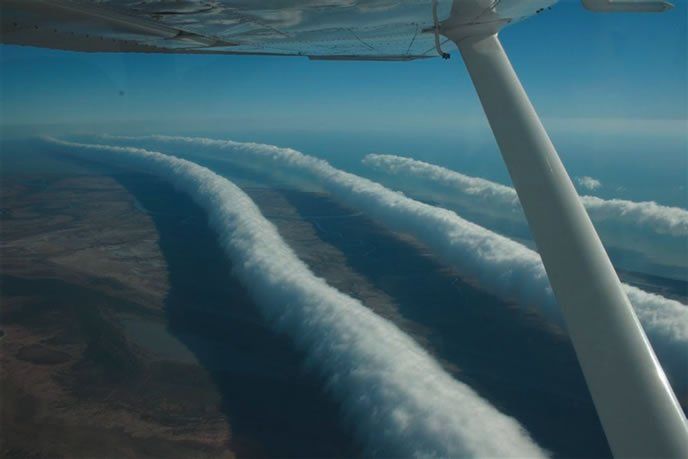There I was, sliding down from my cruising altitude toward my VFR destination, still 30 or so miles out. It had been a smooth ride, and Otto was following a heading and descending at the selected 400 fpm. I had let the power come up during the descent, along with airspeed. The big Continental in front of me was rumbling along at about 25 squared, still leaned for cruise altitude, and airspeed was well into the indicators yellow arc, Thats when it got bumpy. Too bumpy.
The sunny Florida winter day-not unlike spring elsewhere in North America-was great for warming my bones, but also was heating the air and producing updrafts. Looking outside, there was no real clue as to where the bumps would be-in every direction was clear blue sky. I punched off the autopilot, gently added back pressure to level the nose and pulled off several inches of manifold pressure, letting airspeed drop well below the airplanes published design maneuvering speed, or VA, because I was light. I would be home a few minutes later, thanks to my slower groundspeed, but Id get home. And Id be able to use the airplane again.
Its Everywhere
Although we usually prefer smooth air, turbulence is everywhere, and often unavoidable. Its present in the usual places: downwind of mountain ranges or obstructions near a runway, when following a large airplane, in and near thunderstorms, where two competing airmasses collide and, as I found out that day over Florida, in clear air at any altitude. Although it can be easy to predict where turbulence can be found, its almost impossible to predict its absence.
Turbulence can mean a rough, uncomfortable ride for all aircraft occupants, of course, and injuries in severe cases (usually involving airliners with people up and walking around). While en route, it can translate into greater fatigue for the crew, and creates operational considerations-like gusty, unpredictable conditions for landings and takeoffs-when encountered close to the ground. For a variety of reasons-safety, comfort, efficiency-it should be avoided. Except we usually cant avoid turbulence. I say usually, because there are times and places we can avoid it.

Just east of Albuquerque, N.M., is a well-defined mountain ridge running north/south. If the winds are blowing across that ridge and you cross them within a few thousand feet of their peaks, there will be some enthusiastic bumps, their energy depending on the winds strength and your altitude. Meanwhile, those white puffies dotting the flatlands in summer point out two things: Underneath them is rising air, which forms the clouds as it cools and moisture condenses. Fly through or underneath one of them and itll be bumpy. Climb above their bases, however, and youll usually get a smooth ride for your trouble. Meanwhile, large bodies of water tend to absorb heat energy during the day, by contrast to the land surrounding them. In summer, the land tends to reflect the suns energy, creating updrafts. Over the water, however, you might see a downdraft, or simply encounter fewer updrafts during the day. At night, the warmer water can produce its own turbulence.
The point is many turbulence encounters shouldnt come as a surprise. Terrain and weather often conspire to create bumps; where and when youll encounter them can be obvious, if you know what to look for. All thats well and good, but how to handle turbulence when it cant be avoided?
Speed To Fly
The main thing about dealing with turbulence usually is slowing down. Letting down into my Florida destination, I wasnt thinking about bumps in the clear skies that time of year, and let the speed creep up into the yellow arc. Thats a big no-no when flying turbulence: You never want to be in the airspeed indicators yellow arc-if you even have one-in anything except smooth air.
Most airframe manufacturers publish speeds to use in turbulence or rough air. Youll usually find them in the POH/AFMs front portion, perhaps in a section dedicated to and defining the aircrafts various recommended speeds. There usually is a placard on or near the instrument panel listing this airspeed. Typically, the speed given will be VA, design maneuvering speed, at gross weight, which the FAAs Airplane Flying Handbook, FAA-H-8083-3B, defines as the maximum speed where full, abrupt control movement can be used without overstressing the airframe.
A subsequent definition, courtesy of FAA Special Airworthiness Information Bulletin (SAIB) CE-11-17, published in 2011, states, design maneuvering speed (VA) is the speed below which you can move a single flight control, one time, to its full deflection, for one axis of airplane rotation only (pitch, roll or yaw), in smooth air, without risk of damage to the airplane. (emphasis in the original) As the sidebar on the previous page highlights, however, the published speed may need to be corrected for weight.
Another speed is VO, operating maneuvering speed. Its similar to VA, in that its also weight-dependent, but the FAA defines VO as the maximum speed where, at any given weight, the pilot may apply full control excursion without exceeding the design limit load factor. Operating is used to maintain a distinction from the design maneuvering speed, VA. Its published for newer Part 23 airplanes, like the Cirrus SR 20, and some Cessnas, including the 162 Skycatcher. Cirrus defines it as the maximum speed at which application of full control movement will not overstress the airplane.
Maintaining Control
Okay, so theres no choice: Youre about to penetrate an area of turbulence, perhaps downwind of a mountain peak, or in or near convective activity. What to do? What are the targets you should aim for? Start with the suggestions in the sidebar on the opposite page.
Make sure wing flaps are retracted and remain that way. Extending landing gear may or may not be an option; if you have the choice, putting it down likely will increase drag and limit any tendency to build speed. Of course, we need to set power to what little is necessary to maintain at or below our targeted turbulence penetration speed, VA, VO, or V-whatever-the-manufacturer-recommends, corrected for weight, in level flight. That helps solve the speed issue.
The main things we want to accomplish here is keep the wings level at or below our target airspeed. Happily, nailing one can help maintain the other: If we keep the wings level, the airplane cant tuck into a steep spiral and build speed. The wings-level task can be assisted by a compliant autopilot, but many are clearly placarded against use in severe or extreme turbulence. Yes, theres an official definition of that kind of turbulence, but only the pilot can decide if conditions meet it.
Pitch control is the remaining big challenge in turbulence. The natural instinct is to chase the airplanes turbulence-induced altitude excursions-pull off power in climbs, and add it in descents-but thats a bad idea. Do your best to maintain a constant attitude, not altitude, perhaps around five degrees nose-up. Accept altitude excursions. If youre IFR, tell ATC you need a block altitude. If they dont give it to you, tell them youre off your altitude anyway. Theyll move people around, even though if its that rough, all the smart ones are somewhere else. We would tend to stay off the rudder pedals, using our feet to correct gross excursions, but our primary concern is keeping the rudder centered.
The Softer Kind
Those are some of the keys to dealing with severe and extreme turbulence. But the moderate and light chop kinds deserve some attention, too. Keep in mind, however, that the average run-of-the-mill light chop isnt that much of a deal, structurally. One of my normal landings can produce more G-force than the average summer-afternoon turbulence, but the latter is much less comfortable.
In other words, its usually a good idea to get out of light or moderate chop for comfort reasons, but not for structural ones. Yes, repeated exposure to turbulence-hundreds or thousands of hours-can fatigue an airframe, but 30 minutes of light chop wont hurt anything as long as airspeed is kept under control. Flying in this kind of turbulence can mean a slow slog. So dont.
Find a different altitude, with smoother air. Get above those white puffies, or top the haze layer. The only time youll regret climbing to a smoother altitude is coming back down through the bumps at the destination, when youll be tempted to keep your speed up. Bad idea. Pick a different time of day-mornings can be smooth as glass; so can evening and night flying. You also can choose a different route: you dont always have to go through Albuquerque.




